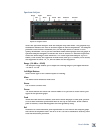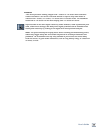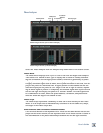
User’s Guide
RMS Level
RMS (expanded view)
Root Mean Square (RMS) is an audio measurement that correlates signal energy
with a reference signal. Neither a peak, nor an average, RMS is derived by squaring
all the instantaneous voltages from a waveform, averaging the squared value, and
then taking the square root of that value. Thus, RMS is a mathematical measure-
ment devised to characterize the level of a given signal. RMS Level is a measurement
that is very helpful in describing the energy of a waveform in RMS values. RMS
levels are similar to average values and do not vary much even when high transient
peaks are presented. The ratio between the Peak and the RMS is called the crest
factor. The meter is calibrated to display 0 dB with a sine wave input at 0 dBFS (Full
Scale). These meters are measured in dB and range from –96 to 0 dB. A square wave
has a crest factor of 1.0. The RMS meter is calibrated for the crest factor of a sine
wave such that a digital peak-to-peak signal (0 dBFS) will report 0 dB.
Meter Graph : What the Meters Measure
Peak to Peak
RMS
RMS = Peak / 2 = Peak x 0.0707
Peak = RMS x 2 = RMS x 1.414


















